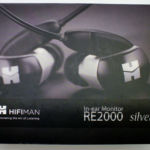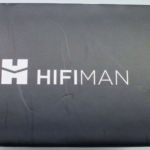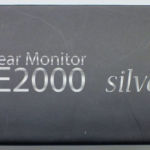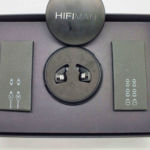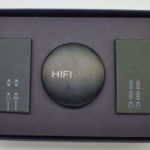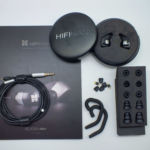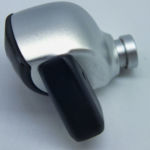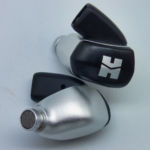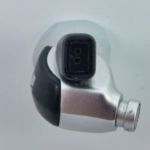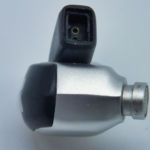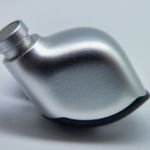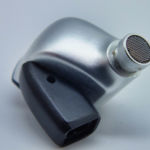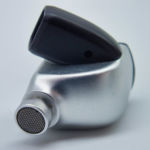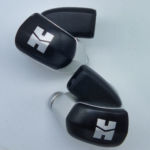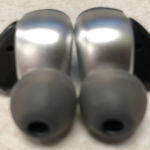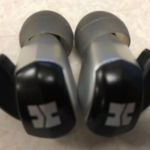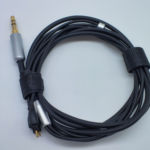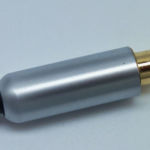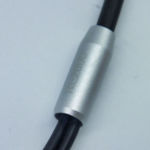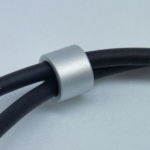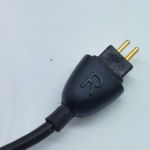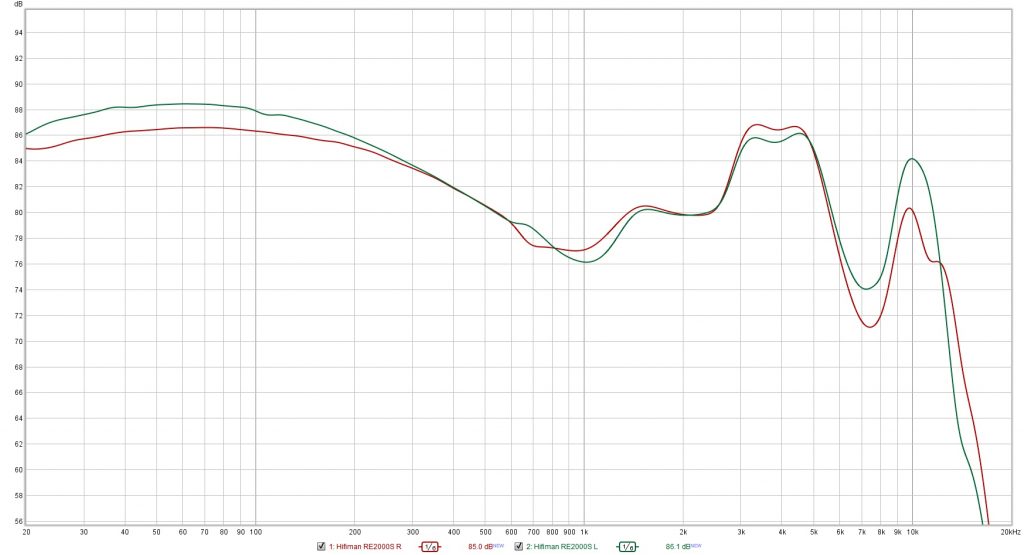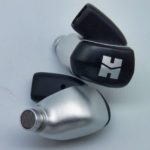Hifiman Re2000 Silver
disclaimer: I received the Hifiman Re2000 Silver as part of the North American tour and would like to thank Hifiman for allowing me to give them a test drive. I have no financial interests in Hifiman, and when the review period ended, these were sent to the next person on the tour so I have received no compensation of any form in exchange for this review. Arrived 9/9
Unboxing / Packaging:
Unboxing may vary slightly as I was not the first participant so my experience may be a bit less exciting than would be presented with a new package. The box has an outer slipcover with graphics on the front and reverse. The inner box is a lift top two part design with a foam tray resting inside that contains a box on either side of a round metal case that contains the earpieces. The left box contains the cable and the right a fairly complete selection of tips with three single flanged and 3 double flanged. Other spare parts are hiding beneath the tray including a set of ear-hooks for those that prefer them, spare connectors for the cable and housing parts for the same.
Build/Fit:
The Re2000 has a unique box shape that makes it pretty immediately recognizable. The bulk of the body is polished aluminum with a plastic housing for the bi-pin connector (as best I can tell, apologies to Hifiman if it is aluminum) as it feels to have more flex than the rest of the body. The square shape of the shell is smoothed on the inside so is actually considerably more comfortable than looks might suggest. Nozzles exit the front of the unit with a slight forward rake and provide a fairly shallow insertion depth which aids in comfort, but somewhat detracts from isolation. What I found interesting was the lack of a vent in line with the driver. The only hole in the casing is at the base of the bi-pin connector housing and without some form of destructive test, I cant tell it if the vent goes into the primary housing or not. On the down side, fit of the face plates is less than ideal as the face-plate on both sides overhangs the back edge noticeably and the amount of silver metal visible at the front of the face-plate is not equal on both sides. These issues can be seen in the last two photos in the gallery below and while not pronounced, they are enough that QC probably should have caught them.
Internals:
Hifiman has spent a lot of ink explaining the new “topology driver” used in the RE2000 iems. This is an upgraded 9.2 mm dynamic driver with the diaphragm being designed with a distinct topology that helps direct the sound waves and minimizes distortion. We have seen a lot of work in this field of late with several manufacturers working on advancing the capabilities of the dynamic driver. Nominal impedance is listed as 60Ω with a sensitivity of 103 dB/mW +/- 3db. This puts the Re2000 into the class where a dedicated amp is likely needed to produce best results. I found I could drive the Re2000 with the LG on high output, but even then, it didn’t open up and perform as well as it did when combined with the iFi xCan or the Oriolus BA300s. The Re2000 is probably best reserved for those with dedicated DAPs or DAC/Amps to really get the full benefit out of it, and at the price-point I would want to get my money’s worth for sure.
Cable:
The provided cable is a bit of a mixed bag. It provides a spare set of pins for the bi-pin connector, which is a nice touch, but has a weak point where the connector attaches to the cable that gives me pause for concern. The cable is Oxygen free copper, but little detail beyond that is provided by Hifiman. From the 3.5 mm straight connector to the splitter is a rubber coated single cable of roughly 3/16th inch diameter which then breaks into two 1/8th inch runs from the split up. Fixtures are brushed aluminum for the jack, splitter, and chin slider, and then black plastic to match the housing color. Hifiman is relatively new to the removable cable market in iems as even some previous flagships lacked them. I am glad to see them make the move to this style, but do think they still have some things to learn with regard to cable quality and options. For a product at this price point, I also expect a 2nd cable in balanced or provide a balanced cable to start with and an adapter for single ended. At $800 this is provided by most of their competition, at the original MSRP of $1500 it is nearly mandatory.
Sound:
The Re2000 is tip sensitive. The provided wide-bore tips give it a bit more treble presence than I prefer but do improve the stage size some. Smaller tips reduce the size of the stage but bring the treble back in-line and push the mid-bass a bit more forward comparatively. I found Shure Olives to be my personal favorite, but of course your mileage may vary so try a few and see what works for you.
Bass:
Bass has good depth with roll-off becoming noticable only in the lower 40Hz range and good rumble when called upon. Mid bass is somewhat elevated, but retains good proportion to the rest of the signature and doesn’t get boomy or loose. The best thing about the low end is how articulate it is with bass runs having good tonality and clean separation between notes. This makes the Re2000s a fun listen with pieces that contain a walking bass line or are more bass focused. While not enough to satisfy the basshead in the bunch, it is certainly an above average experience both in quantity and in quality.
Mids:
Mids on the Re2000s will be the most polarizing feature. With poorly recorded or mastered material, they are wholly unforgiving and sound quite poor. With better source material, they do a great job of rendering detail and great texture for strings. Vocals are slightly forward, but neither gender gets preferential treatment so neither sits forward of the other. Vocals are full without being overly thick and nothing comes off as forced. If there is a downside, the mids are slightly recessed compared to either side of the signature and while mid detail is quite good, it can be easily overlooked as it rarely is the star unless listening to something like string quartets that emphasize mids above all else.
Treble:
The treble on the Re2000s does quite a balancing act. It is pushed forward, but not as much as is typical in V shapes and while it adds some energy to the signature it refrains from getting splashy or strident (pun intended). I find a true reference treble usually sounds a bit lifeless and dull. The Re2000s does a good job of breathing some life back into things with cymbals, bells, and snare rattle all being quite believable without getting metallic or crunchy. Treble detail is also quite good which is another tough balance for an iem that isn’t overly treble forward. Roll-off begins to be fairly evident above about 13kHz but when you have to intentionally throw test tracks at it to find the drop-off, it probably isn’t an issue unless you are just looking for it.
Soundstage / Imaging:
This is the strongest point of the Re2000S. Soundstage is excellent for an in-ear with solid dimensions and a good sense of height. This coupled with above average imaging and instrument separation makes seating the orchestra easy with nothing behind that should be next to and good space between. Movements around the stage are easy to follow and echos feel distant compared to the source. I especially enjoyed binaural recordings like the Cowboy Junkies Trinity Sessions as the Re2000s did a great job of recreating the cathedral with all its nuances.
Thoughts / Conclusion:
I am torn as I write this, in some regards, I really like the Re2000 Silver and I’d like to be able to recommend it, in others, I think it needs some improvements before I can do so. At the price point, there is no excuse for a sloppy build and a fragile cable. Those things alone keep it from being recommendable. I know some who treat their in-ears with kid gloves will never have an issue, but for those who wear them daily while commuting and then have to pack them back in a case, I worry about cable durability. On the flip side, detail retrieval is on par with things a price points considerably above it like the Campfire Atlas or Meze Ria Penta so, for that, I have to give it high marks. I think, in general, Hifiman has a reputation for sterling sound quality with some questionable build choices, and unfortunately, I think the Re2000 Silver continues that legacy. I’d be tempted to buy it from somewhere I could open the package and check the build quality before taking it home, or somewhere with a good return policy in case you get one that isn’t what it should be build wise.
-
Bass - 7.5/107.5/10
-
Mids - 7/107/10
-
Treble - 7.5/107.5/10
-
Soundstage - 8/108/10
-
Imaging - 8/108/10


